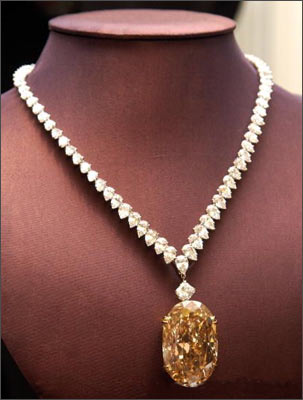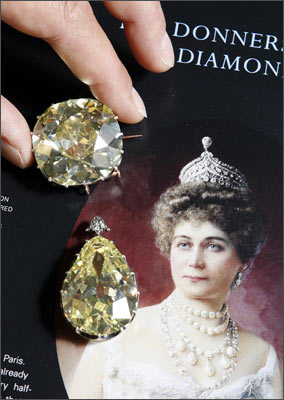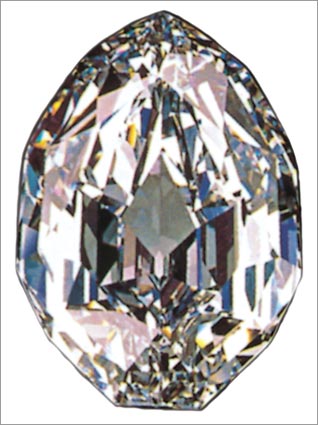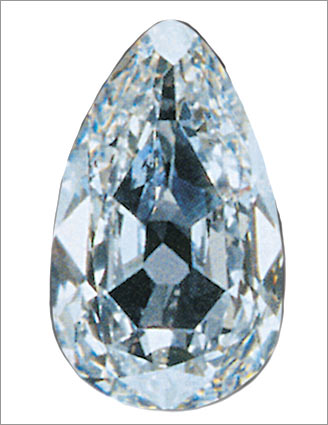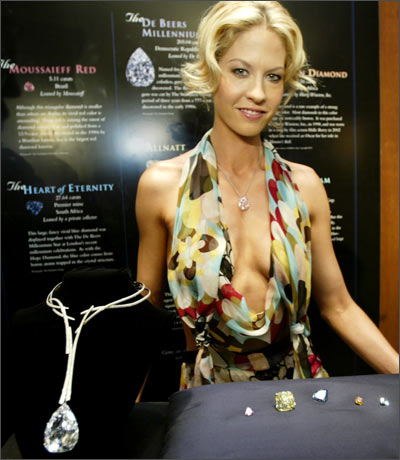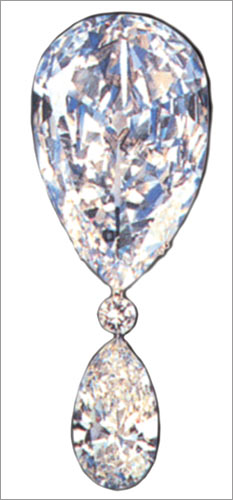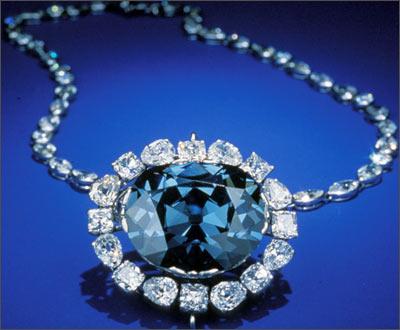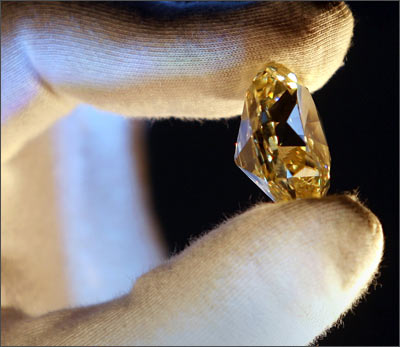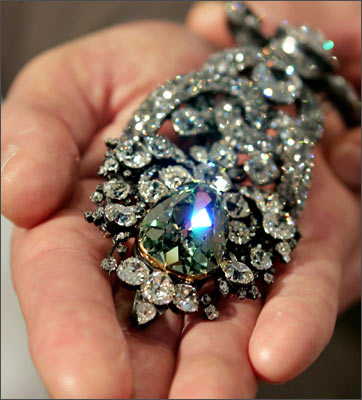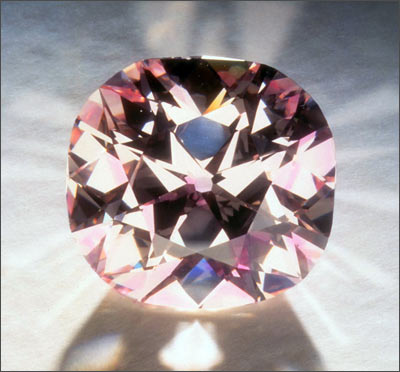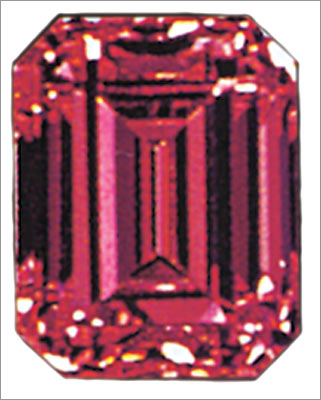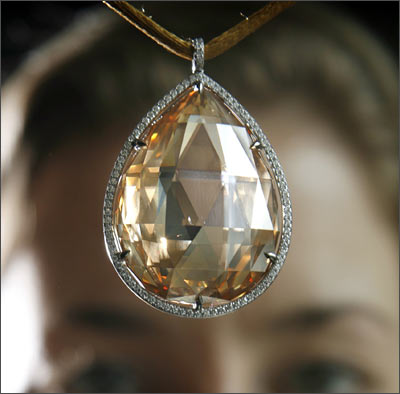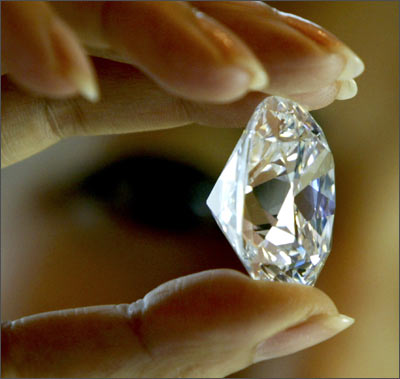 | « Back to article | Print this article |
The world's most beautiful diamonds
Many of the world's famous diamonds have fascinating histories.
Read on to find out more about some these stunning gemstones. Some, of course, are just beautiful because they are too young to have yet developed a history.
The chocolate diamond
This 107 carat chocolate diamond, worth $ 1.7 million, was displayed at the 75th Diamond Anniversary Oscar Collection unveiling at the House of Harry Winston in Beverly Hills, California.
Text: Rediff Business Desk
The Donnersmarck Diamonds
The Donnersmarck Diamonds are exceptional yellow stones with a fascinating and impeccable provenance. One is a magnificent pear-shaped diamond weighing 82.48 carats, the other a magnificent cushion-shaped diamond weighing 102.54 carats. They were sold for $7,912,373.
They were gifted by Furst Henckel von Donnersmarck, a German nobleman, industrial magnate and one of the richest men of his time, to his first wife, Pauline Therese Lachmann, a courtesan better known as La Paiva.
After her death in 1884, Henckel had her naked body immersed in alcohol in an isolated room of his castle at Neudeck and visited her corpse regularly
Information courtesy: Wikipedia
The Mouawad Splendour
In a rather unusual use for a diamond, the 101.84 Mouawad Splendour was incorporated as the centrepiece of Victoria's Secret fantasy bra for 2005.
It came with two matching complementary accessories -- a belt and a pendant necklace -- and was priced at $ 12.5 million.
Information courtesy: Internetstones.com
The Ahmedabad
This brilliant stone was discovered in the 17th century, which confirms its Indian origin -- at that time, India was the only source for diamonds in the world.
The diamond gets its name from the city of Ahmedabad (probably the only diamond cutting centre in the world then), where it was reportedly purchased by Jean Baptiste Tavernier, a famous French traveller and gem trader.
The rough, which was said to weigh over 157 carats, was cut into a 94.5 carat diamond with, said Tavernier, two minor flaws at the base. He also said he bought it for a friend, but the identity of the friend is unclear.
It is known, however, that much later the diamond was owned by Begum Hazrat Mahal, wife of King Wajid Ali Shah of Oudh. When the king's rebellion against the British failed, the Begum fled to Nepal. She later used the diamond to negotiate her safe passage to India.
At this point, the history of this diamond again becomes murky and, when it finally resurfaced, it had been reduced to 78.86 carats. Put up for sale by Christie's in 1995, it was purchased by gem collector Robert Mouawad for approximately $ 4.3 million.
Information courtesy: Internetstones.com
The Lesotho I
The Lesotho rough diamond, weighing in at a massive 601 carats, was accidentally discovered in 1967 and led to the establishment of the Lets'eng diamond mine.
Harry Winston, who purchased the diamond in 1968, cleaved it into 18 pieces that yielded 18 beautiful diamonds. The largest one, an emerald cut weighing 71.73 carats, was called the Lesotho I and has a beautiful pink hue.
Aristotle Onassis bought the 40 carat Lesotho III for Jacqueline Kennedy as an engagement gift. It came up for sale at a Sotheby's auction in 1996, and after a frenzied bidding between two anonymous bidders, sold for $2.59 million.
The Lesotho rough is also famous for being the largest diamond discovered by a woman. It is also the seventh largest rough diamond ever discovered in the world.
Information courtesy: Internetstones.com
The Steinmetz Pink
Its colour, clarity and size make this an extremely rare diamond. In terms of weight -- 59.60 carats -- it is the third largest pink diamond in the world; the first two slots belong to the Darya-i-Nur and the Nur-ul-Ain respectively.
The Steinmetz Pink is a relatively new diamond; it was unveiled to the world in 2003. Its origin is unknown, but the rough stone is believed to have weighed 100 carats.
It is named after the company that owns it -- the Steinmetz Group is considered one of the best diamond cutting companies in the world. Considering the rarity of the diamond, eight master cutters took 20 months to cut and polish the diamond. It is said 50 models of the final look of the diamond were made before the actual cutting took place.
Information courtesy: Internetstones.comThe Indore Pears
This pair of almost identical, pear-shaped diamonds originally weighed 46.95 and 46.70 carats. They were set as a pair of earrings for the Maharani of Indore, Shamista Devi Holkar, by her husband, Tukoji Rao III. Rao, who had been implicated in a murder case, had abdicated the throne in favour of his son and settled in Europe.
During a visit to Switzerland, he met and fell in love with Nancy Anne Miller, a rich young American lady. After their marriage in 1928, she converted to Hinduism and was named Shamista.
When Tukoji Rao decided to sell the diamonds in 1946, it was bought by the legendary jeweller Harry Winston who recut the stones to 46.30 and 44.14 carats to bring out their brilliance.
The stones are presently owned by the famous diamond connoisseur, Robert Mouawad.
Information courtesy: Internetstones.com
The Hope
Though it has been cut over three times -- and pared down from a massive 112 carats to its present weight of 45.52 carats -- it continues to hold the distinction of being the largest blue diamond in the world.
The extremely beautiful diamond -- it has an unusually clear deep blue colour -- has an interesting past. It has its origins in India and is believed to have been found in the Kollur Mines in Golconda. It was said to have been cursed after being stolen from the forehead of the Goddess Sita, where it was embedded.
Since then, it is said to have brought misfortune to its owners, who have included the royalty of France beginning with King Louis XIV and ending, generations later, with King Louis XVI, who was beheaded in the French Revolution.
Many of the royal jewels, including the blue diamond, were stolen. It resurfaced in London in 1812, when it was bought by Henry Philip Hope, who gave the diamond the name by which we know it today.
The final owner of the Hope diamond was jeweller Harry Winston. He donated it to the Smithsonian Institution -- this was the second diamond to delivered through mail in plain packaging; Winston used a plain brown paper bag -- to help build a national gem collection dedicated to the American people.
Information courtesy: Internetstones.com
The Forevermark Fancy Yellow Diamond
It's oval, naturally yellow and stunningly beautiful.
The world's largest Forevermark Fancy Yellow Diamond comes from the De Beers stable and was put up for auction online -- the first of its kind -- on October 7-8 last year.
This brilliant, oval-cut diamond weighs 42.02 carats and was cut painstakingly over a period of three months; the original stone weighed 78.2 carats.
Its auction value was been pegged at somewhere between $ 606,745 and $ 719,100.
However, this one is tiny compared to some of the largest diamonds in the world.
The Dresden Green
The largest and finest natural green diamond ever found, the 40.70 carat Dresden Green derives its name from Dresden, the capital city of Saxony in Germany. An early 18th century stone, it probably came from the Kollur mines near Golconda in southern India.
In the early 18th century, it was purchased by the famous London diamond merchant Marcus Moses, who hoped to sell it to King George I (1714-27) for 10,000 pounds. Later, it was offered to Duke Frederick Augustus I for 30,000 pounds. But none of them purchased it. The diamond was eventually sold to Duke Frederick Augustus II for thaler 400,000.
For a period after World War II, the Russians took the diamond and many other treasures including the crown jewels to Moscow; they were returned in 1958.
The Dresden Green was taken to Washington in October 2000, where it was displayed at the Smithsonian Institution until January 2001. It was then returned to the Albertinium Museum in Dresden, its permanent home.
Information courtesy: Internetstones.com
The Agra
It's a controversial diamond -- the Agra. This beautiful pink diamond has a long history, with many of the earlier accounts still under dispute.
It is believed that in 1526, the first Mughal emperor, Babur, took the Agra from the raja of Gwalior, whom he had defeated in battle. Babur, it is recorded, wore the diamond in his turban.
By 1844, the Agra was owned by the Charles, the Duke of Brunswick; he is said to have paid a massive sum of franc 348,600 for it. In the 19th century, the Agra was reduced to just under 32 carats to eliminate some black inclusions.
In 1990, the Agra was auctioned at Christie's for pound 4,070,000, making it at that time, the most expensive pink diamond in the world.
Since then, the Agra has again been recut to 28.15 carats.
One of the most famous, and largest, pink diamonds in the world is the Darya-i-Nur, which was also part of the crown jewels of the Mughal emperors.
Information courtesy: De Beers Group, Internetstones.com
The Mouawad Lilac
Its early history is not known, but the Mouawad Lilac, which weighs 24.44 carats, probably originated in South Africa, the main source of pink diamonds in the 20th century.
Diamond connoisseur Robert Mouawad purchased it for $1,088,710 when it first appeared at a Soethby's auction on June 5, 1976.
The current estimated value of the stone, which is the seventh largest pink diamond in the world, is $20 million.
Information courtesy: Internetstones.com
The Eureka
For a gem that is said to be the single most important diamond in the history of South African mining, it has a rather inconsequential beginning.
It was discovered in 1856 by a Dutch farmer's children, who used the shiny stone as a toy. A neighbour, who had some geological knowledge, offered to buy it but the family refused the money and gifted it to him instead.
In 1867, it was confirmed as the first diamond discovered in South Africa; it weighed 22.5 carats and was valued at pound 800. It was sold to Sir Philip Wodehouse, the governor of Cape colony, for pound 500 who took it back to England with him in 1870.
It was eventually cut into a cushion cut diamond of 10.73 carats; it is brownish-yellow in colour.
In 1967, a century after its discovery, De Beers purchased the diamond and gifted it to the people of South Africa.
Information courtesy: De Beers Group, Internetstones.com
The orange-brown diamond
Christie's jewellery specialist Helen Molesworth holds up a coloured diamond pendant.
This is an orange-brown briolette-cut diamond, weighing 100.60 carats, within a pave-set diamond hook-and-eye clasp.
First large classic cushion-shape diamond to be auctioned
A staff member holds the largest D colour internally flawless diamond for auction offered by Sotheby's Geneva in Hong Kong.
The diamond, weighing 103.83 carats, was the first classic cushion-shape of more than 100 carats to be offered on sale and was estimated to fetch $ 8,000,000.
